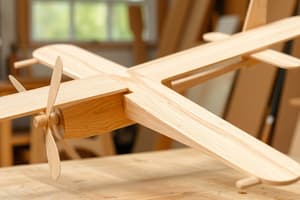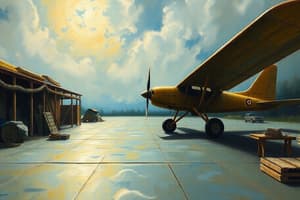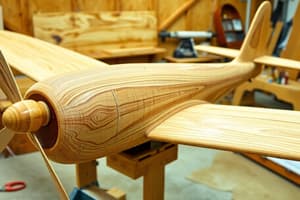Podcast
Questions and Answers
Why is aluminum currently favored over wood in modern aircraft construction, despite wood's historical significance?
Why is aluminum currently favored over wood in modern aircraft construction, despite wood's historical significance?
- Aluminum structures can be created faster with automated processes, while wooden structures need significant handcrafting. (correct)
- Aluminum has a naturally superior strength-to-weight ratio compared to all types of wood.
- Aluminum is less susceptible to decay and fungal growth, requiring less maintenance.
- Aluminum is more readily available and cost-effective than high-quality wood suitable for aircraft.
In laminated wood construction, what is the primary benefit of orienting the grain of each thin wood piece in the same direction?
In laminated wood construction, what is the primary benefit of orienting the grain of each thin wood piece in the same direction?
- It maximizes the wood's resistance to twisting and warping under stress.
- It reduces the overall weight of the component compared to using a single solid piece of wood.
- It simplifies the gluing process, ensuring a stronger bond between layers.
- It allows for the creation of larger structural components from smaller pieces, maintaining consistent strength along the length. (correct)
In plywood construction, why are the layers of wood veneer glued together with the grain of each successive layer oriented at an angle?
In plywood construction, why are the layers of wood veneer glued together with the grain of each successive layer oriented at an angle?
- To enhance the wood's natural resistance to moisture absorption and prevent swelling.
- To reduce the amount of adhesive needed for bonding the layers together.
- To create a more aesthetically pleasing finish with varied wood grain patterns.
- To evenly distribute stresses and strains, which increases overall strength and stability in multiple directions. (correct)
Why is Sitka spruce the most common wood used in aircraft structures?
Why is Sitka spruce the most common wood used in aircraft structures?
Although Douglas fir has superior strength properties compared to Sitka spruce, why is it not as commonly used in aircraft construction?
Although Douglas fir has superior strength properties compared to Sitka spruce, why is it not as commonly used in aircraft construction?
What characteristic makes balsa wood suitable as a core material in sandwich-type panels for aircraft?
What characteristic makes balsa wood suitable as a core material in sandwich-type panels for aircraft?
Why is straight grain a critical requirement for wood used in aircraft structures?
Why is straight grain a critical requirement for wood used in aircraft structures?
Why are spike knots particularly problematic in aircraft wood?
Why are spike knots particularly problematic in aircraft wood?
According to FAA standards, what does grain slope refer to in the context of aircraft wood, and what is the maximum allowable slope?
According to FAA standards, what does grain slope refer to in the context of aircraft wood, and what is the maximum allowable slope?
How do pitch pockets affect the structural integrity of wood used in aircraft?
How do pitch pockets affect the structural integrity of wood used in aircraft?
What is compression wood, and why is it undesirable in aircraft construction?
What is compression wood, and why is it undesirable in aircraft construction?
What distinguishes a check from a shake in wood, and why are both considered defects in aircraft structural components?
What distinguishes a check from a shake in wood, and why are both considered defects in aircraft structural components?
What is a split in wood, and why is it considered a critical defect in aircraft structures?
What is a split in wood, and why is it considered a critical defect in aircraft structures?
What causes stains in wood, and why is recognizing them important in aircraft maintenance?
What causes stains in wood, and why is recognizing them important in aircraft maintenance?
How can decay in wood be prevented, particularly in the context of aircraft construction and maintenance?
How can decay in wood be prevented, particularly in the context of aircraft construction and maintenance?
Flashcards
Solid Wood
Solid Wood
Wood made of one solid piece cut from a log, used for wing spars.
Laminated Wood
Laminated Wood
Wood made of thin pieces glued together with the grain running in the same direction, allowing for larger components.
Plywood
Plywood
Wood consisting of layers of thin veneer glued together with the grain crossed at an angle for strength.
Hardwood
Hardwood
Signup and view all the flashcards
Softwood
Softwood
Signup and view all the flashcards
Spruce
Spruce
Signup and view all the flashcards
Douglas Fir
Douglas Fir
Signup and view all the flashcards
Noble Fir
Noble Fir
Signup and view all the flashcards
Northern White Pine
Northern White Pine
Signup and view all the flashcards
Balsa Wood
Balsa Wood
Signup and view all the flashcards
Birch
Birch
Signup and view all the flashcards
Straight Grain
Straight Grain
Signup and view all the flashcards
Knots
Knots
Signup and view all the flashcards
Pitch Pockets
Pitch Pockets
Signup and view all the flashcards
Compression Wood
Compression Wood
Signup and view all the flashcards
Study Notes
- Nonmetallic structural materials were significant in early aviation, but aluminum's introduction led to their decreased use.
- Aluminum is the most common material for aircraft construction and repair today.
Wood
- Wood is used less in modern aircraft due to the higher cost of labor-intensive construction compared to sheet metal.
Types of Wood
- Solid wood is used for some aircraft wing spars and rigid parts.
- Solid wood is made from a single piece cut from a log and commonly used for bulkheads, landing gear, and spars.
- Laminated wood consists of two or three thin pieces glued together with grains running in the same direction.
- Laminated wood allows splicing for larger components like spars from smaller pieces.
- Plywood is made of at least three layers of veneer glued together with alternating grain angles of 45 or 90 degrees.
Species of Wood
- Two main species used for aircraft are hardwood from broad-leaved trees and softwood from coniferous trees.
- Sitka spruce is the most common aircraft wood due to its lack of defects, high strength-to-weight ratio, and availability in large sizes.
- Douglas fir has greater strength properties than spruce but is heavier, harder to work, and prone to splitting.
- Noble fir is lighter than spruce with equal or superior properties, except for hardness and shock resistance.
- Noble fir is used for parts under heavy bending and compression, such as spars and cap strips.
- Northern white pine has excellent workability and gluing characteristics, but lower strength than spruce.
- Balsa is a very light wood from South America used as a core material in lightweight, rigid sandwich panels.
- Birch is a heavy hardwood with good shock resistance.
- Birch is recommended for plywood face plies on wing spars and wooden propellers.
Quality of Wood
- Wood for aircraft structure must have a straight grain, meaning fibers are parallel to the longitudinal axis.
- Knots indicate where branches grew from the trunk and can be round, oval, or spiked.
- Spike knots are cut parallel to a branch, weaken the wood, and are not allowed in aircraft construction.
- FAA standards permit a maximum grain slope of 1:15
- Pitch pockets are small resin-filled openings within tree rings that slightly weaken the wood.
- Compression wood has wide summer-growth rings due to compressive stress during growth, making it denser and weaker.
- Checks are cracks across annual rings during seasoning.
- Shakes are separations between annual rings.
- Splits are lengthwise separations caused by tearing wood fibers.
- Wood with these defects (checks, shakes, and splits) is not allowed in aircraft structure.
- Decay stains appear as streaks in the grain, extending from the decayed area.
- Decay is caused by fungi in damp wood and prevented by proper seasoning and dry storage.
Studying That Suits You
Use AI to generate personalized quizzes and flashcards to suit your learning preferences.




